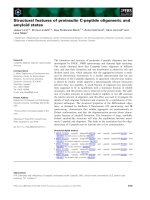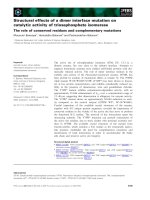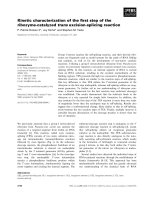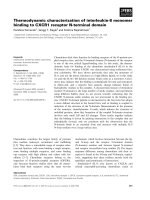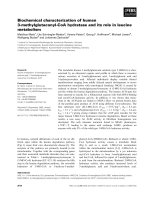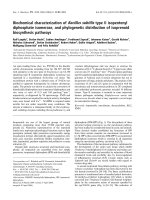Báo cáo khoa học: Structural characterization of L-glutamate oxidase from Streptomyces sp. X-119-6 pdf
Bạn đang xem bản rút gọn của tài liệu. Xem và tải ngay bản đầy đủ của tài liệu tại đây (930.58 KB, 10 trang )
Structural characterization of L-glutamate oxidase from
Streptomyces sp. X-119-6
Jiro Arima
1,2,
*, Chiduko Sasaki
3,
*, Chika Sakaguchi
1
, Hiroshi Mizuno
1
, Takashi Tamura
1
,
Akiko Kashima
3
, Hitoshi Kusakabe
4
, Shigetoshi Sugio
3
and Kenji Inagaki
1
1 Department of Biofunctional Chemistry, Graduate School of Natural Science and Technology, Okayama University, Japan
2 Department of Agricultural, Biological, and Environmental Sciences, Faculty of Agriculture, Tottori University, Japan
3 Innovation Center Yokohama Center, Mitsubishi Chemical Corporation, Aoba-ku, Yokohama, Japan
4 Enzyme Sensor Co. Ltd, Liaison Center 311, University of Tsukuba, Japan
Keywords
L-amino acid oxidase; L-glutamate
oxidase; Streptomyces; substrate
specificity; X-ray crystallographic
structure
Correspondence
K. Inagaki, Department of Biofunctional
Chemistry, Graduate School of Natural
Science and Technology, Okayama
University, Okayama-shi, Okayama
700-8530, Japan
Fax: +81 86 251 8299
Tel: +81 86 251 8299
E-mail:
S. Sugio, Innovation Center Yokohama
Center, Mitsubishi Chemical
Corporation, Aoba-ku, Yokohama
227-8502, Japan
Fax: +81 45 963 4206
Tel: +81 45 963 3663
E-mail:
*These authors contributed equally to this
work
Database
Coordinate and structure factors of the
mature
L-glutamate oxidase have been
deposited in the Protein Data Bank at
the Research Collaboratory for Structural
Bioinformatics under code 2E1M
(Received 26 February 2009, revised 30
April 2009, accepted 18 May 2009)
doi:10.1111/j.1742-4658.2009.07103.x
l-Glutamate oxidase (LGOX) from Streptomyces sp. X-119-6, which cata-
lyzes the oxidative deamination of l-glutamate, has attracted increasing
attention as a component of amperometric l-glutamate sensors used in the
food industry and clinical biochemistry. The precursor of LGOX, which
has a homodimeric structure, is less active than the mature enzyme with an
a
2
b
2
c
2
structure; enzymatic proteolysis of the precursor forms the stable
mature enzyme. We solved the crystal structure of mature LGOX using
molecular replacement with a structurally homologous model of l-amino
acid oxidase (LAAO) from snake venom: LGOX has a deeply buried active
site and two entrances from the surface of the protein into the active site.
Comparison of the LGOX structure with that of LAAO revealed that
LGOX has three regions that are absent from the LAAO structure, one of
which is involved in the formation of the entrance. Furthermore, the
arrangement of the residues composing the active site differs between
LGOX and LAAO, and the active site of LGOX is narrower than that of
LAAO. Results of the comparative analyses described herein raise the
possibility that such a unique structure of LGOX is associated with its
substrate specificity.
Structured digital abstract
l
MINT-7041556: LGOX_gamma fragment (uniprotkb:Q8L3C7), LGOX_beta fragment
(uniprotkb:
Q8L3C7) and LGOX_alpha fragment (uniprotkb:Q8L3C7) physically interact
(
MI:0915)byx-ray crystallography (MI:0114)
Abbreviations
AB, o-aminobenzoate; LAAO,
L-amino acid oxidase; LGOX, L-glutamate oxidase; PAO, polyamine oxidase.
3894 FEBS Journal 276 (2009) 3894–3903 ª 2009 The Authors Journal compilation ª 2009 FEBS
Introduction
l-Glutamate has a flavor-enhancing activity that cre-
ates the sensation of ‘umami’; the monosodium salt of
l-glutamate is widely used as a seasoning for cooking
and as a food additive. The amino acid is also the
principal excitatory neurotransmitter in the brain [1,2].
Furthermore, its excessive release might play a major
role in the neuronal death associated with various
neurological disorders [3]. Therefore, the quantitative
assay of l-glutamate is important in the fields of food
production and clinical biochemistry.
Actually, l-glutamate oxidase (LGOX; EC 1.4.3.11)
was first purified from an aqueous extract of a wheat
bran culture of Streptomyces sp. X-119-6 [4]. Along
with the production of ammonia and hydrogen perox-
ide via an imino acid intermediate, LGOX catalyzes
the oxidative deamination of the a-amino group of
l-glutamate to 2-ketoglutarate, A simple photometric
l-glutamate assay kit and amperometric l-glutamate
sensors using LGOX, based on colorimetric and elec-
trochemical measurements of hydrogen peroxide, are
commercially available. The biosensor is now a useful
tool for in vitro and in vivo monitoring of mammalian
brain l-glutamate [5–7]. In addition, results of recent
studies show that microfluidic biosensors using LGOX
are applicable for the detection of glutamic oxaloace-
tic transaminase, glutamic pyruvic transaminase and
c-glutamyl transpeptidase activities, which are diagnos-
tic markers of liver function [8,9].
LGOXs of several kinds have been identified from
the genus Streptomyces [4,10–12]. An enzyme from
Streptomyces sp. X-119-6 is the sole commercially
available enzyme that is useful for biosensors: it has
high substrate specificity and high stability (thermal
stability, 80 °C; k
cat
=75s
)1
; K
m
= 0.23 mm). A
peculiarity of LGOX from Streptomyces sp. X-119-6 is
that the enzyme has a hexameric structure, a
2
b
2
c
2
; the
precursor has been shown by recombinant expression
to have a homodimeric structure [13]. The precursor
tends to aggregate, has low thermal stability (40 °C),
has low catalytic activity (k
cat
=33s
)1
), and has low
affinity for substrate (K
m
= 5.0 mm). Artificial enzy-
matic proteolysis of the precursor with a metallo-
protease from Streptomyces griseus forms the mature
enzyme with the a
2
b
2
c
2
structure without separation of
large proteolytic fragments. The findings show that
LGOX is expressed in nature as the precursor in an
incompletely active form; the enzyme is digested by an
endopeptidase to yield the active form with an a
2
b
2
c
2
oligomeric structure. The mechanism of this structural
change, with its improvement in properties, is of inter-
est for basic enzymological studies.
Another peculiarity of LGOX is its strict specificity
for l-glutamate. In addition to LGOX, several
l-amino acid oxidases (LAAOs) with strict specificity
have been identified from various microorganisms:
l-lysine-a-oxidase [14], l-phenylalanine oxidase [15,16],
and l-aspartate oxidase [17]. These enzymes are
considered to have an identical catalytic mechanism
but different affinities for amino acid substrates. In
this class of enzymes, the crystal structures of the
LAAO from snake venom and aspartate oxidase from
Escherichia coli are available [18,19]. However, little
information related to the determinant of substrate
specificity of the enzymes is available.
For this study, to investigate the relationship
between biochemical characteristics and structural fea-
tures of LGOX from Streptomyces sp. X-119-6, we
determined its molecular mass and analyzed its
detailed structure. Herein, we describe the crystal
structure of the mature enzyme and compare it with
the LAAO structure. On the basis of comparative
analyses, insights into the structural factors for the
biochemical characteristics of LGOX are discussed.
Results
Molecular mass of LGOX
Our previous study showed that LGOX is expressed as
a single polypeptide precursor in an incompletely
active form. It forms a mature enzyme with a hexa-
meric a
2
b
2
c
2
structure formed through protease modi-
fication [13]. As shown in Fig. 1, the LGOX precursor
has a molecular mass of approximately 75 kDa,
whereas the mature form of LGOX shows four frag-
ments corresponding approximately to 42, 40, 17 and
10 kDa. The N-terminal sequences of the 42 kDa and
40 kDa fragments were established to be ANEMT,
indicating that both fragments were identified as an
a-fragment. The sum of the masses of the a-fragment,
b-fragment and c-fragment of mature LGOX was
approximately 70 kDa, indicating that short pro-
teolytic fragments were separated from the LGOX
molecule through digestion.
On the basis of the molecular mass, we predicted the
region of the respective fragments of mature LGOX.
The regions and the theoretical molecular masses of
the respective fragments are presented in Fig. 2A. MS
analysis of the smaller a-fragment showed a mass of
approximately 39 900 Da (Fig. 1B), indicating that the
C-terminus of this fragment is located at approxi-
mately residue 370. The larger fragment showed a
J. Arima et al. Crystal structure of L-glutamate oxidase
FEBS Journal 276 (2009) 3894–3903 ª 2009 The Authors Journal compilation ª 2009 FEBS 3895
mass of approximately 41 700 Da (Fig. 1B), indicating
that the C-terminus lies closer to the N-terminus of the
c-fragment (Tyr390). We infer that the larger a-frag-
ment is an intermediate formed during protein matura-
tion. An MS analysis of the c-fragment showed a
sharp peak with a molecular mass of 10 570 Da
(Fig. 1B), thereby enabling identification of the posi-
tion of the C-terminal end of this fragment (Ala480).
The results show deletions of 40 residues between the
c-fragment and b-fragment and approximately 20
residues after the C-terminus of the b-fragment. The
difference in properties between the precursor and
mature LGOX may be attributed to distortions of the
single-chain structure with extra amino acid segments
as described above.
Structure determination and structural quality
We attempted to crystallize LGOX as both the pre-
cursor and mature forms to obtain detailed structural
information. Crystals of mature LGOX were grown
at 5 °C using the sitting drop vapor diffusion
method. The LGOX crystals were formed in the pres-
ence of a-ketoglutarate. Nevertheless, in crystallo-
graphic analyses, no electron density corresponding
to the ligand was observed at the active site pocket.
Crystals of the precursor also formed. However, the
crystal quality of the precursor was inadequate for
determination of the structure. On the other hand,
protein crystals were never grown, under any condi-
tions, from LGOX solutions in the presence of either
l-glutamate, l-aspartate, or l-aspargine. Therefore,
we performed structural analysis using only mature
LGOX crystals. The data collection and refinement
statistics for the crystal structure of the mature
LGOX are presented in Table 1. The refined model
contains 356 residues in the a-fragment, 151 residues
in the b-fragment, 90 residues in the c-fragment, an
FAD, and four phosphate anions with an R-factor
and R
free
of 24.8% and 30.8%, respectively, in the
resolution range 45.3–2.8 A
˚
.
Overall structure
The overall structure is shown in Fig. 3A. The mature
LGOX comprises an oligomeric dimer, with each pro-
tomer containing three fragments (abc) and a bound
FAD. The protomer in the crystal asymmetric unit
forms a biological dimer with its own symmetry equiv-
alent, and interacts in a head-to-tail orientation with
the substrate-binding site facing away from the dimer
interface. Within a single protomer, the chain of each
fragment is substantially entangled with the other
chains (Fig. 3A). This finding is in agreement with the
endopeptidase modification that occurs after protein
folding. The electron densities for amino acids 1–17,
364–376, 387–390, 481–522 and 674–701 are not visi-
ble; crystallographic analysis revealed approximate
cleavage sites on the single-polypeptide LGOX.
The FAD prosthetic group is buried deep within the
enzyme. It undergoes extensive interactions with the
protein residues. The FAD adopts a conformation
resembling that seen in other FAD enzymes. In the
LGOX structure, the domain interacting with the dinu-
cleotide moiety of FAD comprises six discontinuous
regions of the structure: Val64–Gly70, Leu87–Ile98
AB
Fig. 1. SDS ⁄ PAGE and MS analysis of
LGOX. (A) SDS ⁄ PAGE of LGOX. Lane M
includes molecular weight protein markers.
Lanes 1 and 2, respectively, include precur-
sor LGOX and mature LGOX. The N-terminal
amino acid sequences of the a-fragments,
b-fragments and c-fragments are shown
at the side of the panel. (B) MS analysis of
LGOX. Upper panel, LGOX precursor;
middle panel, a-fragment; lower panel,
b-fragment and c-fragment.
Crystal structure of
L-glutamate oxidase J. Arima et al.
3896 FEBS Journal 276 (2009) 3894–3903 ª 2009 The Authors Journal compilation ª 2009 FEBS
A
B
Fig. 2. Amino acid sequence of LGOX and structure-based sequence alignment of LGOX with LAAO. (A) The sequence is the primary struc-
ture deduced from the nucleotide sequence of LGOX. The region of the a-fragment is highlighted in black, that of the c-fragment is high-
lighted in dark gray, and that of the b-fragment is highlighted in light gray. Identified protease cleavage positions are indicated by black
arrowheads. The dotted line under the sequence shows a possible cleavage position, as identified using MS analysis. The theoretical values
of molecular masses of respective fragments are shown. The value presented in parenthese3s is the theoretical molecular mass of a smaller
fragment of the a-fragment. (B) Structure-based sequence alignment of LGOX with LAAO. The N-terminal residues of the a-fragments and b
fragments for which no electron density was observed are presented in lower-case letters. The secondary structural elements are indicated
by cylinders showing the a -helices and arrows indicating b-strands with numbering of the secondary structure. Residues conserved between
both enzymes are highlighted in black. Functionally similar residues are highlighted in gray. The residues composing the active site are indi-
cated by #.
J. Arima et al. Crystal structure of
L-glutamate oxidase
FEBS Journal 276 (2009) 3894–3903 ª 2009 The Authors Journal compilation ª 2009 FEBS 3897
and Gln352–Met354 in the a-fragment, Thr404–Ser409
in the c-fragment, and Tyr613–Gly616 and Gly644–
Glu645 in the b-fragment (Fig. 3B). The isoalloxazine
ring of FAD is positioned at the interface between the
FAD-binding domain and the substrate-binding
domain.
Structure analysis revealed two funnel-shaped
entrances (1 and 2 in Fig. 4A) extending from the
surface of the protein into the interior, terminating at
the active site near to the FAD cofactor. The presence
of the long funnel is a charcteristic of a number of fla-
voenzymes. The funnel of LGOX is composed mainly
of the residues of the a-fragment. The residues com-
posing the active site are contained in the a-fragment
and b-fragment. The LGOX surface has two funnel
entrances (entrances 1 and 2 in Fig. 4A). Both
entrances were observed to be approximately 20 A
˚
from the active site.
Structural comparison with LAAO
A 3D molecular structure comparison using the dali
[20] program revealed that the overall structure of
LGOX resembles those of LAAO with Z = 41.3
Table 1. Data collection and refinement statistics for the crystal
structure of mature LGOX. R-merge = R(|(I –<I>)|) ⁄ R(I).
R = R|F
o
– F
c
| ⁄ R|F
o
|.
Crystal cell parameter
Unit cell parameter
a, b, c (A
˚
) 123.88, 123.88, 168.76
a, b, c (°) 90, 90, 120
Space group P6122 (178)
Relative molecular mass 77 804
Collection and reduction
Wavelength (A
˚
) 1.0000
Resolution limit (A
˚
) 2.6
No. of total reflections 244 533
No. of unique reflections 24 388
Completeness (last shell) (%) 100 (100)
I ⁄ r 29.7
R
merg
(last shell) (%) 8.2 (51.4)
Refinement
Resolution range (A
˚
) 45.3–2.8
No. of unique reflections 19146
R (R
free
) (%) 24.8 (30.8)
rmsd (A
˚
) Bonds, 0.008 A
˚
; angle, 1.5°
No. of protein residues 597 of 628
Chemical components PO
4
, 4; FAD, 1
B-factor (A
˚
2
)
All atoms 34.3
Protein atoms 34.3
Main chain atoms 33.87
Side chain atoms 34.78
FAD 21.85
PO
4
62.49
Ramachandran plot
Most favored (%) 85.6
Additional allowed (%) 12.8
Generously allowed (%) 1
Disallowed (%) 0.6
A
B
Fig. 3. Overall structure and local structure around FAD of the
mature LGOX. (A) The functional hexamer with two protomers
(a
2
b
2
c
2
). On the left-hand side of the protomer, a-fragments, b-frag-
ments and c-fragments are, respectively, colored orange, green,
and blue. FAD is shown in the CPK color scheme. The N-terminals
of b-fragments and c-fragments and the C-terminals of a-fragments
and c-fragments are indicated by arrows. (B) View of LGOX in the
region of the FAD prosthetic group. The protein main chain is repre-
sented as a coil; FAD is shown as a stick. Side chains of the resi-
dues around FAD are depicted as wires. The regions and residues
in a -fragments, b-fragments and c-fragments are, respectively,
colored orange, green, and blue.
Crystal structure of
L-glutamate oxidase J. Arima et al.
3898 FEBS Journal 276 (2009) 3894–3903 ª 2009 The Authors Journal compilation ª 2009 FEBS
(Fig. 5) and polyamine oxidase (PAO) with Z = 25.7,
although the primary structure of LGOX exhibits
approximately 20% and 12% identity, respectively,
with those of LAAO and PAO. The alignments of
sequences and secondary structure elements of LGOX
and LAAO are presented in Fig. 2B. Through struc-
tural comparison, we located three insertions in
LGOX, Asp150–Asn192, Ser246–Trp262, and Thr450–
Ala480, which were not found in the structure of
LAAO (Figs 2B and 5). These regions exist on the sur-
face of LGOX. In fact, the Asp150–Asn192 region is
involved in the formation of entrance 2 of the funnel.
The LGOX funnel shape is more complicated than
that of LAAO (Fig. 4A). Residues at both entrances
are presented in Fig. 4B. Through comparison of the
enzymes’ funnel shapes, the cavity of the active site
(space around the N5 of FAD) of LGOX was found
to be narrower than that of LAAO. A structural
study of PAO also revealed a U-shaped funnel, which
is more complicated than that of LAAO [21]. The
LGOX funnel shape and length resemble those of
PAO (30 A
˚
) (Fig. 4A). However, the comparison
also revealed a narrower active site in LGOX than
in PAO.
A
B
Fig. 4. Structural comparisons of the funnels of LGOX, LAAO, and PAO, and the residues composing two entrances of the funnel of LGOX.
(A) Stereo view of funnels of LAAO, PAO, and LGOX. The surfaces of the enzyme molecules are colored green, and the space that can
accommodate a substrate in the funnel is shown as a gray tube. This tube is funnel-shaped. Black arrowheads indicate funnel entrances. (B)
Stereo view of the residues composing two entrances of the funnel of LGOX. The residues associated with the construction of the
entrances are presented as coils and sticks, colored according to the atom type. FAD is shown in the CPK color scheme.
J. Arima et al. Crystal structure of
L-glutamate oxidase
FEBS Journal 276 (2009) 3894–3903 ª 2009 The Authors Journal compilation ª 2009 FEBS 3899
We next examined the structural differences between
LGOX and LAAO. The active site residues of LGOX
were superimposed on the model of LAAO containing
o-aminobenzoate (AB) as a ligand (Fig. 6A). Several
residues composing the active sites of both enzymes
are mutually identical. The residues corresponding to
Ile374 and Gly212 of LAAO are, respectively, Trp564
and Arg305 in LGOX. Because of the bulkiness of the
residues, the active site of LGOX is narrower than that
of LAAO. Moreover, the polar residues Glu219 and
His223 of LAAO are, respectively, replaced by His
and Gly in LGOX (His312 and Gly316 in Fig. 6A).
The differences described above partially explain their
different substrate specificities.
Discussion
This study revealed the crystal structure of mature
LGOX. The results show that the structure of LGOX
resembles that of LAAO. Structural comparison
revealed several differences between LGOX and LAAO:
LGOX has three regions on the surface that were not
found in the LAAO structure (Fig. 5); differences also
exist in funnel formation (Fig. 4A) and the arrangement
of the residues composing the active sites (Fig. 6A).
Comparison of the arrangement of the active site res-
idues of LGOX, LAAO and d-amino acid oxidase
revealed that the residues of LGOX are more similar to
those found in LAAO (Figs A and 6B), suggesting that
the arrangements of active site residues of LGOX and
LAAO are responsible for strict enantioselectivity. In
fact, LAAO can oxidize a wide range of hydrophobic
amino acids [22,23]. In contrast, LGOX exhibits strict
Fig. 5. Structural comparison of the overall structures of LGOX and
LAAO. The structure of LGOX is shown as an orange coil; regions
that cannot be found in the structure of LAAO are shown as blue
coils and sticks. The LAAO structure is shown as a light green coil.
FAD is shown in the CPK color scheme.
A
B
Fig. 6. Comparison of the active sites of
LGOX, LAAO, and
D-amino acid oxidase. (A)
Stereo view of the active site of LGOX
superimposed on that of LAAO (Protein
Data Bank code: 1F8S). (B) Stereo view of
the active site of LGOX superimposed on
that of
D-amino acid oxidase (Protein Data
Bank code: 1C8I). The regions of their active
sites were superimposed along the isoallox-
azine ring. The residues of LGOX are shown
as blue sticks; those of LAAO and
D-amino
acid oxidase are shown as green sticks. AB
molecules observed in the structure of
LAAO–AB and
D-amino acid oxidase–AB
complexes are shown as sticks colored
according to the atom type. FAD is shown
in the CPK color scheme. The black arrow-
head indicates N5 of the isoalloxazine ring.
Crystal structure of
L-glutamate oxidase J. Arima et al.
3900 FEBS Journal 276 (2009) 3894–3903 ª 2009 The Authors Journal compilation ª 2009 FEBS
substrate specificity towards l-glutamate. This differ-
ence in specificity is probably associated with the differ-
ences in conformations of the active sites, as well as
entry points into the structures of the enzymes. Pawelek
et al. reported that, in the crystal structure of the
LAAO–AB complex, three AB molecules are visible
within the funnel [18]. On the basis of that observation,
they proposed the trajectory of the substrate to the
active site of LAAO. The structure of LAAO with its
substrate, l-phenylalanine, revealed a Y-shaped funnel
system [24]. It was suggested that the function of this
funnel was to allow the amino acid substrate and O
2
into the active site. In the LGOX structure, the two
funnel-shaped entrances lead from the surface to the
active site. The shapes of the LGOX and LAAO fun-
nels differ greatly (Fig. 4A). The LGOX funnel shape
resembles that of PAO (Fig. 4A). Previous reports of
the PAO structure show that its U-shaped funnel acts
as an entry and exit point for the substrate and product
[21]. Moreover, an exact match between the inhibitors
and the PAO funnel was revealed in the structure of
the PAO–inhibitor complex [25]. Similarly, we surmise
that the entrances of the funnel of LGOX have a dis-
tinctive function.
As portrayed in Fig. 6, the arrangements of many res-
idues composing the substrate-binding sites of both
LAAO and LGOX are similar. However, differences in
terms of the properties of their side chains are apparent
in several residues. The residues corresponding to Ile374
and Gly212 of LAAO are, respectively, Trp564 and
Arg305 in LGOX; consequently, the active site of
LGOX is narrower than that of LAAO. Moreover,
His223 of LAAO is replaced by Gly in LGOX (Gly316
in Fig. 6A). In fact, His223 of LAAO is expected to
assist hydride transfer and to be important for substrate
entry [18]. Because there is no equivalent residue around
Gly316 of LGOX, further studies are necessary to clar-
ify which residue assists hydride transfer. In addition to
the replacement of His223 by Gly, residue Glu219 of
LAAO is replaced by His312 in LGOX (Fig. 6A).
Therefore, along with the architecture of the active site,
the residue substitutions between the two enzymes alter
the electrostatic environment significantly. These obser-
vations suggest that the differences in amino acid resi-
dues engender differences in the electrostatic and steric
environments around the active sites of both enzymes
and result in differences in substrate specificity.
In addition to the substrate specificity, LGOX exhib-
its a hexameric structure (a
2
b
2
c
2
), induced by endo-
peptidase digestions. The LGOX precursor with a
homodimeric structure has a propensity to aggregate.
Furthermore, it exhibits low thermal stability, low
catalytic activity, and poor substrate affinity. Chen et al.
reported that, by the recombinant expression of LGOX
from Streptomyces platensis using Streptomyces lividans,
the enzyme was expressed in S. lividans cells as a precur-
sor. Moreover, the mature enzyme modified by endo-
peptidase is observed in the extracellular fraction [12].
We speculate that the LGOX activity that catalyzes the
oxidation of l-glutamate along with the production of
ammonia and hydrogen peroxide is toxic for or has a
negative influence on the growth of cells. Consequently,
it is considered that LGOX is present in cells as a pre-
cursor form that has low activity, and that the enzyme is
digested by an endopeptidase to yield the active form
with an a
2
b
2
c
2
oligomeric structure after secretion. The
present study demonstrated that the artificial enzymatic
proteolysis of the precursor forms the a
2
b
2
c
2
structure
without the separation of large proteolytic fragments.
Actually, the results of MS analysis indicate that the
LGOX precursor has a single-chain structure with two
extra regions (Fig. 2A). Further study of the structures
of LGOX, in addition to investigation of the precursor
form and LGOX–ligand complex, might shed light on
the detailed molecular characteristics associated with
the unique properties of LGOX.
Experimental procedures
Protein purification
The LGOX precursor was purified from the cell lysate of
E. coli JM109 harboring the plasmid for LGOX production,
pKK–LGOX, as described by Arima et al. [13]. The purified
single-chain precursor was treated with the metalloprotease
from S. griseus (Sigma-Aldrich Corp., St Louis, MO, USA)
at room temperature for 4 h. Then it was heated at 60 °C for
30 min to inactivate the protease. After centrifugation
(12 000 g, 10 min), the solution was loaded onto a column
(DEAE-Toyopearl 650; Tosoh Corp., Tokyo, Japan) equili-
brated with 20 mm potassium phosphate buffer (KPB) (pH
7.4) containing 0.1 m NaCl. The bound protein was eluted
with 20 mm KPB (pH 7.4) containing 0.3 m NaCl. The eluate
was pooled and dialyzed against 20 mm KPB (pH 7.4); the
dialysate was used as the purified mature enzyme sample.
Molecular mass of LGOX
The molecular mass of LGOX was determined using
SDS ⁄ PAGE and MALDI-TOF MS (Autoflex II TOF ⁄
TOF; Bruker Daltonics Inc., Bremen, Germany). SDS ⁄
PAGE was performed with a 12% gel under denaturing
conditions [26]. For MS analysis, the enzyme (1 mg ⁄ mL)
was dialyzed against Milli-Q water. The dialysate was then
mixed with the MALDI matrix solution. The mixture was
then used for MS analysis.
J. Arima et al. Crystal structure of L-glutamate oxidase
FEBS Journal 276 (2009) 3894–3903 ª 2009 The Authors Journal compilation ª 2009 FEBS 3901
Determination of N-terminal amino acid
sequence
The purified enzymes were blotted onto a poly(vinylidene
difluoride) membrane after 12% SDS ⁄ PAGE under dena-
turing conditions. The membrane was then stained using
Coomassie brilliant blue. The protein band was excised
from the membrane. The protein bands were used to deter-
mine the N-terminal amino acid sequence through Edman
degradation.
Crystallization
Crystallization was performed using LGOX precursor and
mature forms. However, for the precursor form, crystals
sufficient for structure determination were not obtainable.
Crystals of mature LGOX were grown at 5 °C using the sit-
ting drop vapor diffusion method by mixing a protein solu-
tion [10 mg ⁄ mL protein in 20 mm KPB (pH 7.4) with
5mm dithiothreitol] and reservoir solution [1200 mm
NaH
2
PO
4
, 800 mm K
2
HPO
4
, 200 mm LiSO
4
, 100 mm Caps
(pH 6.2)] in a 1 : 2 ratio. Rod-shaped yellowish crystals
were grown in 3–4 weeks to sufficient size for use in diffrac-
tion studies.
Data collection and structure determination
The crystals were transferred into a harvest solution con-
taining 1200 mm NaH
2
PO
4
, 800 mm K
2
HPO
4
, 200 mm
LiSO
4
100 mm Caps (pH 10.5), and 20% glycerol, and
flash-cooled in a nitrogen stream at 100 K. The LGOX
crystals were of hexagonal space group P6
1
22, with the
following unit cell dimensions: a = b = 123.88 A
˚
,
c = 168.76 A
˚
.
A dataset was collected at Spring-8 BL24 (Hyogo,
Japan). Diffraction data were processed using the
HKL2000 [27]. The structure was solved using molecular
replacement with amore [28] with the structure of LAAO
from snake venom (Protein Data Bank code: 1F8S). The
resulting electron density maps were of sufficiently good
quality to trace the polypeptide chain.
Crystallographic refinement
Refinement of the structure was conducted using cnx [29]
against 2.8 A
˚
diffraction data. The final atomic model con-
tained a-fragments 18–363 and 377–386, c-fragment 391–
480, and b-fragment 523–673. The crystallographic R-factor
and free R-factor were 0.248 and 0.308, respectively
(Table 1). Analysis of crystal packing revealed that one
abc heterotrimer is involved in the asymmetric unit. Two
heterotrimers (a
2
b
2
c
2
) are mutually related by their crystal-
lographic two-fold symmetry representing the known
biological oligomerization state of LGOX with their own
symmetry equivalent.
Acknowledgements
This study was partly supported by a research grant
from the National Project on Protein Structural and
Functional Analysis from the Ministry of Education,
Culture, Sports, Science, and Technology of Japan.
We thank T. Hatanaka, Research Institute for Biologi-
cal Sciences (RIBS), Okayama, for his kind help in
permitting us to use ICM software for structural
comparison.
References
1 Beart PM (1975) An evaluation of l-glutamate as the
transmitter released from optic nerve terminals of the
pigeon. Brain Res 110, 99–114.
2 Collingridge GL & Lester AJ (1989) Excitatory amino
acids receptors in the vertebrate central nervous system.
Pharmacol Rev 40, 143–209.
3 Meldrum BS & Garthwate J (1990) Excitatory amino
acid neurotoxicity and neurodegenerative disease.
Trends Neurosci 11, 379–387.
4 Kusakabe H, Midorikawa T, Fujishima A, Kuninaka A
& Yoshino H (1983) Purification and purification of a
new enzyme, l-glutamate oxidase, from Streptomyces
sp. X-119-6 grown on wheat bran. Agric Biol Chem 47,
1323–1328.
5 Zilkha E, Obrenovitch TP, Koshy A, Kusakabe H &
Benneto HP (1995) Extracellular glutamate: on-line
monitoring using microdialysis coupled to enzyme-
amperometric analysis. J Neurosci Methods 60, 1–9.
6 Miele M, Berners M, Boutelle MG, Kusakabe H &
Fillenz M (1996) The determination of the extracellular
concentration of brain glutamate using quantitative
microdialysis. Brain Res 707, 131–133.
7 Ryan MR, Lowry JP & O’Neill RD (1997) Biosensor
for neurotransmitter l-glutamic acid designed for effi-
cient use of l-glutamate oxidase and effective rejection
of interference. Analyst 122, 1419–1424.
8 Upadhyay S, Ohgami N, Kusakabe H & Suzuki H
(2006) Electrochemical determination of gamma-glutam-
yl transpeptidase activity and its application to a
miniaturized analysis system. Biosens Bioelectron 21,
1230–1236.
9 Upadhyay S, Ohgami N, Kusakabe H, Mizuno H,
Arima J, Tamura T, Inagaki K & Suzuki H (2006)
Performance characterization of recombinant l-gluta-
mate oxidase in a micro GOT ⁄ GPT sensing system.
Sens Actuators B Chem 119, 570–576.
10 Kamei T, Asano K, Suzuki H, Matsuzaki M & Nakam-
ura S (1983) l -Glutamate oxidase from Streptomyces
violascens. I. Production, isolation and some properties.
Chem Pharm Bull 31, 1307–1314.
11 Bohmer A, Muller A, Passarge M, Liebs P, Honeck H
& Muller HG (1989) A novel l-glutamate oxidase from
Crystal structure of L-glutamate oxidase J. Arima et al.
3902 FEBS Journal 276 (2009) 3894–3903 ª 2009 The Authors Journal compilation ª 2009 FEBS
Streptomyces endus. Purification and properties. Eur J
Biochem 182, 327–332.
12 Chen CY, Wu WT, Huang CJ, Lin MH, Chang CK,
Huang HJ, Liao JM, Chen LY & Liu YT (2001) A
common precursor for the three subunits of l-glutamate
oxidase encoded by gox gene from Streptomyces platen-
sis NTU3304. Can J Microbiol 47, 269–275.
13 Arima J, Tamura T, Kusakabe H, Ashiuchi M, Yagi T,
Tanaka H & Inagaki K (2003) Recombinant expression,
biochemical characterization and stabilization through
proteolysis of an l-glutamate oxidase from Streptomy-
ces sp. X-119-6. J Biochem 134, 805–812.
14 Kusakabe H, Kodama K, Kuninaka A, Yoshino H,
Misono H & Soda K (1980) A new antitumor enzyme,
l-lysine alpha-oxidase from Trichoderma viride. Purifica-
tion and enzymological properties. J Biol Chem 255,
976–981.
15 Koyama H (1982) Purification and characterization of a
novel l-phenylalanine oxidase (deaminating and decarb-
oxylating) from Pseudomonas sp. P-501. J Biochem 92,
1235–1240.
16 Koyama H (1983) Further characterization of a novel
l-phenylalanine oxidase (deaminating and decarboxylat-
ing) from Pseudomonas sp. P-501. J Biochem 93, 1313–
1319.
17 Nasu S, Wicks FD & Gholson RK (1982) l-Aspartate
oxidase, a newly discovered enzyme of Escherichia coli,
is the B protein of quinolinate synthetase. J Biol Chem
257, 626–632.
18 Pawelek PD, Cheah J, Coulombe R, Macheroux P,
Ghisla S & Vrielink A (2000) The structure of l-amino
acid oxidase reveals the substrate trajectory into an
enantiomerically conserved active site. EMBO J 19,
4204–4215.
19 Mattevi A, Tedeschi G, Bacchella L, Coda A, Negri A
& Ronchi S (1999) Structure of l-aspartate oxidase:
implications for the succinate dehydrogenase ⁄ fumarate
reductase oxidoreductase family. Structure 7, 745–756.
20 Holm L & Sander C (1993) Protein structure compari-
son by alignment of distance matrices. J Mol Biol 233,
123–138.
21 Binda C, Coda A, Angelini R, Federico R, Ascenzi P &
Mattevi A (1999) A 30-angstrom-long U-shaped
catalytic tunnel in the crystal structure of polyamine
oxidase. Structure
7, 265–276.
22 Massey V & Curti B (1967) On the reaction mechanism
of Crotalus adamanteus l-amino acid oxidase. J Biol
Chem 242, 1259–1264.
23 Arima J, Uesugi Y, Iwabuchi M & Hatanaka T (2006)
Study on peptide hydrolysis by aminopeptidases from
Streptomyces griseus, Streptomyces septatus, and
Aeromonas proteolytica. Appl Microbiol Biotechnol 70,
541–547.
24 Moustafa IM, Foster S, Lyubimov AY & Vrielink A
(2006) Crystal structure of LAAO from Calloselasma
rhodostoma with an l-phenylalanine substrate: insights
into structure and mechanism. J Mol Biol 364, 991–
1002.
25 Binda C, Angelini R, Federico R, Ascenzi P & Mattevi
A (2001) Structural bases for inhibitor binding and
catalysis in polyamine oxidase. Biochemistry 40, 2766–
2776.
26 Laemmli UK (1970) Cleavage of structural proteins
during the assembly of the head of bacteriophage 4.
Nature 15, 680–685.
27 Otwinowski Z & Minor W (1997) Processing of X-ray
diffraction data collected in oscillation mode. Methods
Enzymol 276, 307–326.
28 Navaza J (1994) Jorge Navaza’s state-of-the-art molecu-
lar replacement package. Acta Crystallogr 50, 157–163.
29 Brunger AT, Adams PD, Clore GM, DeLano WL,
Gros P, Grosse-Kunstleve RW, Jiang JS, Kuszewski J,
Nilges M, Pannu NS et al. (1998) Crystallography &
NMR system: a new software suite for macromolecular
structure determination. Acta Crystallogr D Biol Crys-
tallogr 54, 905–921.
J. Arima et al. Crystal structure of L-glutamate oxidase
FEBS Journal 276 (2009) 3894–3903 ª 2009 The Authors Journal compilation ª 2009 FEBS 3903
